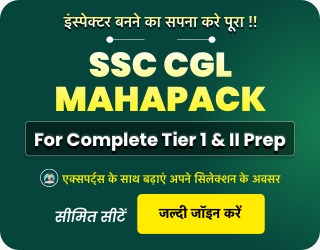Table of Contents
SSC CPO Selection Process 2025
The Staff Selection Commission(SSC) is going to conduct the SSC CPO 2025 recruitment process. Lakhs of candidates participate in the SSC CPO exam to fulfil their aspirations of getting a government job. Knowing the selection process is very important and comes to mind after completing the application process.
The SSC CPO selection process includes 4 stages namely Paper 1, PET/PST, Paper 2, and Medical Examination, and all the stages are qualifying in nature. Go through the below article for the details of the SSC CPO Selection Process 2025.
SSC CPO Selection Process
Once you are acknowledged with the SSC CPO selection process you can start the preparation accordingly. Have a look at the selection process mentioned below.
- Paper 1 Written Exam
- Physical Endurance Test (PET)/ Physical Standard Test (PST)
- Paper 2 written exam
- Medical Examination
SSC CPO Exam Pattern 2025
The SSC CPO Exam Pattern 2025 is explained below.
- Questions asked in both paper-1 and paper-2 of SSC CPO will be of Objective Multiple Choice Type.
- Questions asked will be bilingual, i.e. in both Hindi and English.
- 0.25 marks will be deducted for each incorrect answer.
SSC CPO 2025 Exam will be conducted in three-phase:
| Tier | Type of Examination |
| Tier-I | Objective Multiple Choice |
| PET/PST | Running, Long Jump, High Jump, and Short Put |
| Tier-II | Objective Multiple Choice |
The final merit list will be tabulated based on a candidate’s performance in all three phases of the SSC CPO Exam.
SSC CPO Exam Pattern 2025– Paper I
The SSC CPO Exam Pattern 2025 for Paper 1 is detailed below.
- The Exam will be an Objective Multiple Choice Type.
- A deduction of 0.25 marks will be made for each incorrect answer marked.
| Part | Subject | Questions | Maximum Marks | Duration |
| Part A | General Intelligence and Reasoning | 50 | 50 Marks | 2 Hours |
| Part B | General Knowledge and General Awareness | 50 | 50 Marks | |
| Part C | Quantitative Aptitude | 50 | 50 Marks | |
| Part D | English Comprehension | 50 | 50 Marks | |
| Total | 50 | 200 Marks | ||
SSC CPO 2025- Physical Standard Test (PST)
Only those candidates, who have scored above the cut-off marks fixed by the Commission in Paper I would be required to appear in the Physical Endurance Test/Medical examination. Only those candidates, who qualified in PET/PST and were found medically fit will be allowed to appear in SSC CPO Paper II
Physical Standard Test for Male Candidates:
| Activity | Time |
| 100 Meters Race | 16 Seconds |
| 1.6 Km Race | 6.5 Minutes |
| 3.65 Metres Long Jump | 3 Chances |
| 1.2 Metres High Jump | 3 Chances |
| Shot put (16 Lbs) | 4.5 Metres, 3 Chances |
Physical Standard Test for Female Candidates:
| Activity | Time |
| 100 Meters Race | 18 Seconds |
| 800 Metres Race | 4 Minutes |
| 2.7 Metres (9 Feet) Long Jump | 3 Chances |
| 0.9 Metres (3 Feet) High Jump | 3 Chances |
SSC CPO Syllabus 2025– Click to Check
SSC CPO 2025 Medical Examination
- Candidates who pass the paper 2 examinations and turn up for the medical test will be assessed by the medical officers of the CAPFs/ Central/State Government Hospital or Dispensary.
- Candidates who are assessed to be unfit are informed about the same. Within the time of 15 days, they can apply for review by the Medical Review Board.
- The decision from the Review Medical Board is considered to be final and no further appeals are entertained.
SSC CPO Exam Pattern 2025– Paper II
- The questions in SSC CPO Exam paper 2 will be of Objective Multiple Choice Type.
- A negative marking of 0.25 marks will be made for each incorrect answer marked.
| Subject | Maximum Marks /Questions | Duration and timing |
|---|---|---|
| English language & Comprehension | 200 marks/200 questions | Two Hours |
| Other Links Related to SSC CPO | |
| SSC CPO Notification | SSC CPO Syllabus |
| SSC CPO Salary | SSC CPO Previous Year Question Paper |
| SSC CPO Score Card | SSC CPO Cut Off |



 SSC Selection Post Selection Process 202...
SSC Selection Post Selection Process 202...
 RRB ALP Selection Process 2025, CBT 1, C...
RRB ALP Selection Process 2025, CBT 1, C...
 TNPSC Group 4 Selection Process 2025, Ch...
TNPSC Group 4 Selection Process 2025, Ch...




